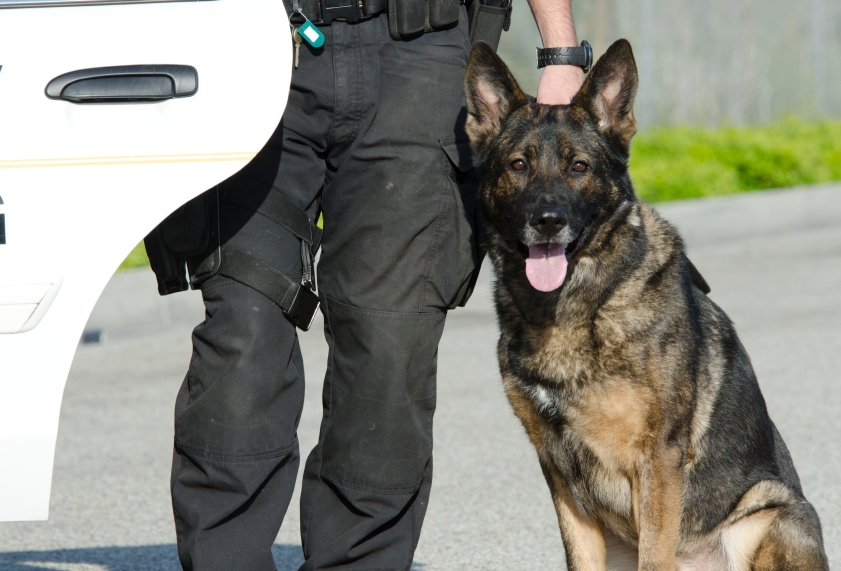Training Working Dogs - Police Dogs and Assistance Animals

February 23, 2010 –Tristan Andrews
In today's world, working dogs are a fact of life. These dogs selflessly provide a service to their masters and their communities and are rewarded with adoration and praise. Police dogs provide such an important service that, in some areas, the killing of a police animal is just as serious an offense as murdering an officer of the law. That in itself is quite a tribute to the work these animals perform.
But what goes into the training of one of these fine animals? Have you ever taken the time to think about how many hours are put into sorting the working animals from the common pets? How much effort is placed on teaching these animals how to do their job in protecting and serving their masters either in official police form or as an assistance dog, such as Seeing Eye or Hearing Ear dogs?
The training of Police dogs alone accounts for many hundreds of man-hours spent for just one animal. Trainers spend many hours researching, locating and acquiring suitable breeds for service dogs and then the dogs must fall within the correct age bracket being neither too young nor too old for service with most dogs ranging between ten months on the young side and two and a half years on the older side. The dogs are then given complete physicals including blood work and X-ray pictures to be certain that they can withstand the stresses and situations the job throws at them. The dogs are required to do pre-tests to determine eligibility for the program as well as aptitude and the pre-tests include such things as whether the dog is approachable by strangers without extreme shifts in behavior, retrieval behavior and foreign object acceptance, such as horses, umbrellas and objects not encountered daily. These tests are used to match the dog to its specific line of work as in patrol, cadaver, narcotics or explosive training. There is much rigorous testing of the animals before any true training ever begins and matching the animal's temperament and personality to the correct trainer is one of the biggest criteria to effective training. If the two personalities clash then the whole training process can be disrupted or, worse, destroyed beyond repair. Dogs are matched to trainers and allowed to bond with their trainers before the earnest training ever begins, thus establishing a trust relationship between the man and the animal that will be crucial in the field later.
Now the difficult task of training begins, with each trainer customizing the lessons to their own style in addition to the age and abilities of the dog. There are classes in different tracking methods, aggression behaviors, environmental dangers, gun conditioning and protecting the handler. The dogs must learn and qualify on these procedures before moving on to the next lesson. Each of these lessons requires many hours of skilled and consistent training just as does any other form of specialized work.
Besides these basic lessons, there are also the specialized lessons such as small item retrieval, explosive and drug location, obstacle avoidance and circumvention, along with how to handle a combative subject and escalated force routine. These animals must also learn to deal with distractions, large crowds, tracking in rural, urban and suburban environments and unusual objects, such as umbrellas and weapons. Remember that there are many hours spent on each of these lessons and that the average dog/handler team is in the field for a year before they become effective and you have a huge amount of training going on. What happens to the dogs that just can't learn all the behaviors? While some are qualified enough to be accepted for other programs such as the Seeing Eye or Hearing Ear programs to assist the physically challenged, most become ordinary but very well trained house pets. For those accepted into the other assistance dog programs, a whole new line of training begins which utilizes their previous training while involving such things as leading the blind thru obstacles using a specially made halter or learning to recognize environmental threats such as smoke, fire, vehicles and tripping hazards and alerting their handlers to the presence of these things. These lessons alone count for many more hours of training.
What does the dog get from all of this? A reward you could never imagine... The love of a trainer and handler that is served well. The affectionate hug of a child whose daddy came home tonight because a well-trained dog put its life on the line. The caress and praise of a blind child who has new freedom because of an animal that leads them where they want to go and protects them from danger. These dogs are rewarded for what they do and rewarded well because they serve well. Think about that the next time you see one of these dogs on the street and remember all the training that goes in to making sure they protect and serve with pride.
About the Author
Tristan Andrews is a freelance author who writes about dog training [https://dogs.net/articles/training-obedience/] and pet insurance [https://dogs.net/articles/pet-insurance/].
Distributed by ContentCrooner.com
GoArticles.com






